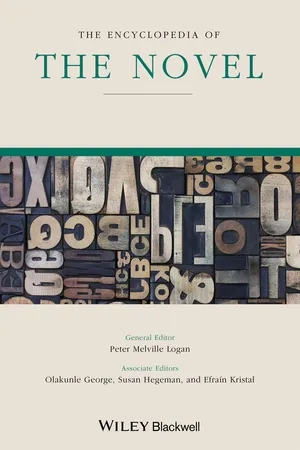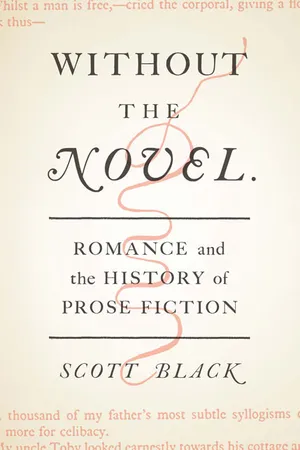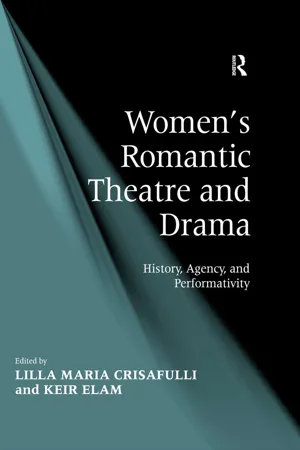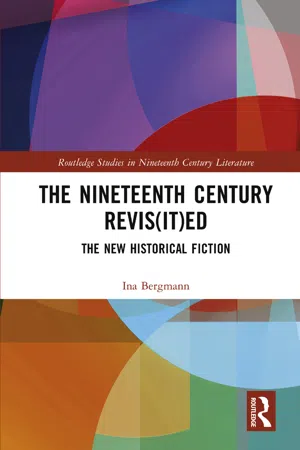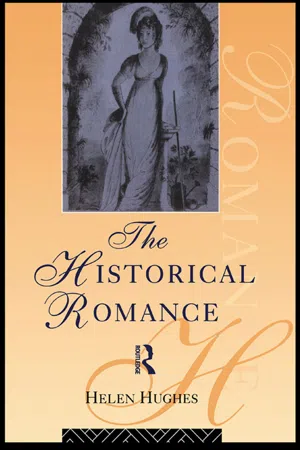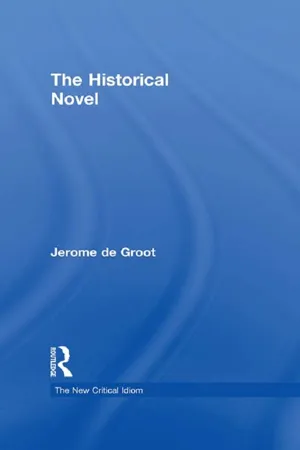Literature
Historical Romance Fiction
Historical romance fiction is a genre of literature that typically takes place in a historical setting and focuses on a romantic relationship as a central theme. These novels often feature strong, independent heroines and dashing heroes, and they provide readers with a blend of historical details and passionate love stories. The genre is known for its ability to transport readers to different time periods while exploring the complexities of human emotions.
Written by Perlego with AI-assistance
Related key terms
Related key terms
1 of 4
Related key terms
1 of 3
8 Key excerpts on "Historical Romance Fiction"
- eBook - ePub
Literature for Young Adults
Books (and More) for Contemporary Readers
- Joan L. Knickerbocker, James A. Rycik(Authors)
- 2019(Publication Date)
- Routledge(Publisher)
Brown and St. Clair (2006) maintain that a work should only be labeled historical fiction if it is about a clash between opposing sociopolitical powers (p. 11). Fire From the Rock (Draper, 2007), for instance, is the story of an individual student, but it is also the story of a political struggle between people demanding change and those who are determined to preserve the inequalities of the past. The setting is integral to the events in the story; it could even be argued that the time and place caused the story’s events. There is also the conundrum of how to categorize mysteries, suspense, and romances set in the past. Does a reader look for a romance set in the past or a work of historical fiction that has a fictionalized romance? What about a fictionalized romance about people that actually existed, such as Melissa de la Cruz’s Alex and Eliza: A Love Story (2017)? Continuum of Historical Contexts Johnson (2002) raises the question of whether or not a novel is considered historical might be relative, so that one reader might consider a novel historical and another does not. For our purposes, a simple definition works best. Historical fiction is a fictional story set in the past. It is important to understand, however, that the past will influence the events and characters in varying degrees. The influence of a historical setting may be thought of as a continuum, as shown in Figure 5.1. At one end is a narrative in which historical references establish a social, political, and cultural backdrop without tying the characters to any specific event - eBook - ePub
- Peter Melville Logan(Author)
- 2014(Publication Date)
- Wiley-Blackwell(Publisher)
These histories also highlighted audiences' desire for fiction. As assessed in this context, fiction was by definition about love—“The Persians first affected up this kind of amorous literature,” Salmasius stated, introducing in 1640 a new translation of the ancient Greek romance, The Loves of Clitophon and Leucippe (qtd. in McMurran, 58). Fiction was also itself a love-object, inspiring an attachment that, commentators maintained, spread globally like a contagion. Seventeenth-century prefaces that recounted in allegorical mode the successive retranslations of particular fictions reasserted that emphasis on spatial diffusion and emphasis on desirability. An English example from 1623 thus personifies the text it introduces as it recounts how the rogue-hero of Mateo Aleman's Gúzman de Alfarache (1605, The Life of Guzmán de Alfarache) wandered, telling his tale as he went, from Spain to France and thence to England to steal more hearts there. In this context, histories of the novel—or, to use the terminology of the day, of “the progress of romance”—recorded how a captivating form took “advantage of permeable frontiers” (DeJean, 175). Ancients vs. Moderns Yet the same histories that portray the globetrotting that fiction does as a constant in cultural history also in other passages lay out a scheme in which fiction is the product of an epochal break, its literary specificity predicated on the revolutions that terminate stable tradition and inaugurate dynamic modernity. The characteristic gesture of the historian as Michel de Certeau has described it—“separation”; “breakage”—is at work in this scheme. For de Certeau, history writing begins with an initial act of division, which severs past from present—as the historian assumes a gap to exist between the reality historiography seeks to express and the place of its own speech—and that division is repeated and repeated until one has a chronology composed of a cavalcade of periods - eBook - ePub
Without the Novel
Romance and the History of Prose Fiction
- Scott Black(Author)
- 2019(Publication Date)
- University of Virginia Press(Publisher)
Introduction Romance and the Turbulence of Literary History Reading is not always a modern activity. Readers may get carried away by their books, lose themselves, or discover themselves enchanted. An activity of temporal displacement as much as historical placement, reading may short-circuit the progress assumed by modernity, producing eddies in time or introducing pockets of the past into the present. At such moments, books too are carried along and realized anew, resurfacing in strange worlds, out of place, reanimated in other minds. The genre of romance is formed at such seams of time, when ancient forms seem to live on like zombies refusing to die and stalking us through our daylight worlds with fantastic anxieties and embarrassing pleasures. 1 Romance is also formed of the seams of time, of temporal knots, loops, or vortices that register and provoke an experience of transhistorical reading—across different times, irresolvable into one. At the genre’s several sites of origin, foundational romances present themselves as secondary, belated, and critical adaptations of strange, archaic, or foreign narratives. In updating such alien stories, these originary romances also self-consciously relay them, offering a space in the contemporary world in which to stage, explore, and enjoy the continuing force of old forms - eBook - ePub
Women's Romantic Theatre and Drama
History, Agency, and Performativity
- Keir Elam, Lilla Maria Crisafulli(Authors)
- 2016(Publication Date)
- Routledge(Publisher)
If we go back to Scott’s approach to historical narrative we notice that his ‘medieval’ novels differ entirely from the previous ones, which were set in recent Scottish history. While history was rapidly turning into a science based upon original and indisputable documents, literature took upon itself to provide a popular version of official history and to explore aspects that mainstream history was not allowed to touch upon. Literary works therefore offered a private version of history, which was paradoxically anachronistic because the past was reconstructed by juxtaposing episodes belonging to different ages; even historical characters could be turned into hybrid, fictional figures, and submitted to revision and reinterpretation. 4 Another important aspect of Romantic historicism is that it took into consideration not only public figures but also common people, and the way they were affected by and reacted to history. Romantic historicism was therefore largely pragmatic, and focused on the true maker of history, the social body, and on its everlasting conflict with great historical figures. 5 Obviously, to re-write history appeared easier when literature drew upon a far-away past rather than the recent one. These new concepts of history and historical narrative rapidly spread among the members of the middle class, to which most readers of historical fiction and most theatre-goers belonged. This explains how women managed to take part in the creation of innovative concepts of historical fiction and drama, and of new narrative and theatrical techniques. A politically oriented interpretation of historical literature, which considered its realistic elements more important than its fictional ones, was sure to ignore women’s contribution to historical literature - eBook - ePub
The Nineteenth Century Revis(it)ed
The New Historical Fiction
- Ina Bergmann(Author)
- 2020(Publication Date)
- Routledge(Publisher)
Historical fiction was often a field of critical controversy (…Johnston/Wiegandt 9; Burt xi; Engler/Müller; Kurt Müller 35; Johnson, Historical 2; Borgmeier/Reitz 8–11). Many of the contemporary books are enthusiastically reviewed in journals, newspapers, and magazines and satisfy the aesthetic requirements of a literarily trained, intellectual audience. The most blatant manifestation of the literariness of the new historical fiction is the success of the genre when it comes to prestigious prizes. If one applies the simplest, naturally contestable definition of the genre – “a novel in which the action takes place during a specific historic period well before the time of writing” (Baldick 114) – most of the winners of the Pulitzer Prize for Fiction and the National Book Award over the last twenty-five years can be identified as historical fiction (Harlan 109). But what is even more striking is that a majority of the novels are set in the nineteenth century. Georges Letissier asserts that “[i]t is now a well-established fact that the Victorian age has become historically central to late postmodernism” (111). Along with the rise of the neo- (Shiller), retro- (Shuttleworth), or post-Victorian novel (Kucich/Sadoff xiii; Kirchknopf 64–66) in British and New English literatures (Moore 136; King 6), the nineteenth century has prominently come into focus in American historical fiction. In a modification of Eric Hobsbawm’s designation of the long nineteenth century in Great Britain (1789 to 1914), Jürgen Osterhammel’s global definition of the long nineteenth century in Die Verwandlung der Welt: Eine Geschichte des 19. Jahrhunderts (2010) spans the period from 1770 to 1918/19 (102–03). This periodization, if applied to literature, yields the result that the dominating number of new historical novels work with a nineteenth-century sujet - eBook - ePub
- Helen Hughes(Author)
- 2003(Publication Date)
- Routledge(Publisher)
If the narrative incorporates a good deal of historical details, the impression is given that this is the result of indefatigable scholarly research, and so—of course—true. Some of Janice Radway’s respondents (in Reading the Romance) clearly believed this: one remarked: ‘You don’t feel you’ve got a history lesson, but somewhere in there you have.’ 7 This use of imaginary detail to produce an effect of ‘fact’, however, considerably antedates Radway’s 1970s ‘bodice-rippers’; it may almost be considered an essential part of the historical novel, since it is found in the work of Scott, and is very noticeable in later nineteenth-century writers such as Ainsworth and Reade, and in novels by more respected writers such as George Eliot’s Middle-march (1871), which has references to Wordsworth, Humphry Davy and the Catholic Emancipation Bill. In Scott’s Rob Roy (1817) the story is dated ‘early in the eighteenth century’, but the date is soon confirmed by a detailed description of the appropriate period costume of Mr Osbaldistone’s clerk (with ‘pearl-grey silk stockings’ and ‘plaited ruffles’). 8 In the typical romance, the romantic situations of the plot comprise narrative motifs which move the story forward, and, in addition, a number of tiny incidents and details which make the reader continually conscious of the historical context in which the story is taking place. Any one of the plots could be broken down into what Umberto Eco, writing of the film Casablanca in The Role of the Reader 9 has called ‘common’ and ‘intertextual’ frames—though in the case of a book, Boris Tomashevski’s word ‘motif’, meaning the smallest unit of plot, might be a better term. 10 ‘Common’ frames appeal to our normal experience—eating a meal, for example. ‘Intertextual’ frames (as when ‘the hero fights the villain and wins’) 11 are stereotyped situations from textual tradition - eBook - ePub
- Jerome De Groot(Author)
- 2009(Publication Date)
- Routledge(Publisher)
chapter 2 ). And finally, the innate alienness of historical fiction serves to suggest that having any prior awareness is of little consequence.LITERARY FICTION AND HISTORY
For the moment, though, let us focus our discussion on British and what has been termed Anglophone writing. In 1984 when the influential literary journal Granta published their first ‘Best of Young British Novelists’ list historical fiction writing was generally absent, as it similarly was in 1994 when the second list appeared, but in 2004 many of the young writers featured took history as their subject. Similarly, since the nomination of Rose Tremain's Restoration and Kazuo Ishiguro's The Remains of the Day (the eventual winner) in 1989, the Booker prize has frequently recognised Anglophone historical fiction. Booker judge Natasha Walter noted the upsurge of interest in historical settings, particularly in novels by women, in a 1999 essay that lamented how these new fictions were over-researched and inert: ‘can all this pretty detail substitute for the vigour of real imaginative engagement with a novelist's own times?’ (Walter 1999).Writing historical novels is no longer something to be considered vulgar, the preserve of romance writers, or guaranteed to tie one to a particular type of genre. ‘That recent British and anglophone fiction has taken a historical turn has become an axiom of critical commentary,’ writes Suzanne Keen (Keen 2006: 167), and she argues that, of all the sub-genres of the novel, the historical is the only one that has been widely, successfully and respectfully used by contemporary literary writers. Keen quotes Linda Duguid's judgement that historical fiction has ‘become respectable, even intellectual’ (cited in Keen 2006: 168). Of course, it might be argued that the literary turn to the historical form of the 1990s was merely a return; aschapter 2 - eBook - ePub
Reading Historical Fiction
The Revenant and Remembered Past
- Kate Mitchell, N. Parsons(Authors)
- 2012(Publication Date)
- Palgrave Macmillan(Publisher)
While academic interest in historical fiction has been strong for much of the late twentieth century, the relationship between the past and the present as it is mediated by the literary text is now being constituted and assessed in new and innovative ways both within the academy and in the public sphere. The public interest in, and esteem accorded to, historical fiction is reflected in bestseller lists and literary prizes – most notable, perhaps, is the dominance of historical fiction in Man Booker and Orange Prize short lists, and the establishment of the Walter Scott Prize for historical fiction in 2010 – while the extent of academic interest is demonstrated by the number of recent monographs that reassess historical fiction within discrete literary periods.Existing scholarship about the relationship between past, present and future in historical fiction focuses almost exclusively on the author’s production of historical meaning, assessing the mediation in individual texts of different historical sources and the use of specific literary techniques. As a result it overlooks the role the reader plays in mediating or even renegotiating that relationship. Michael Pickering and Emily Keightley have recently faulted postmodern accounts of meaningmaking processes for denying the agency of the reader, or audience, proceeding instead ‘as if particular texts are inevitably tied to specific responses’ (2006, 929). They argue that these explanatory frameworks assume that literary and other medial representations are ‘passively accepted by the audience, resulting in loss of meaning at the site of reception’ (2006, 929). This critical focus on the text elides the role of the reader in producing historical meaning. Yet, as Astrid Erll has recently observed, the potential of fiction to produce historical consciousness must be ‘realised
Index pages curate the most relevant extracts from our library of academic textbooks. They’ve been created using an in-house natural language model (NLM), each adding context and meaning to key research topics.
Explore more topic indexes
Explore more topic indexes
1 of 6
Explore more topic indexes
1 of 4

